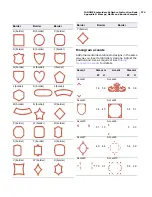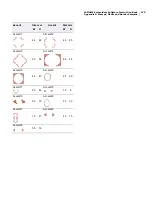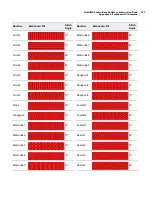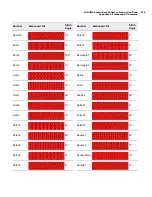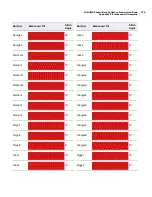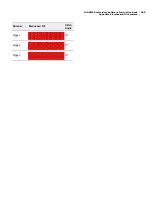
JANOME Embroidery Software Instruction Book
Glossary
288
Design Window: The Design
Window is where designs are
displayed for viewing and
modification.
Desktop: MS Windows
terminology for the screen
background on which program
icons are displayed.
Destination folder: The folder
(directory) where you intend to
copy or move one or more files.
Detail: An outline, a border, a
pickout run, or a small area of the
design you want to be stitched out
last when using Click-to-Design.
Diagonal backstitch: The
backward rows are diagonal,
directly connecting the forward
rows. Diagonal backstitch is
suitable for turning shapes, and
gives good results with Jagged
Edge. See also
Backstitch
.
Dialog: An on-screen box that
either requests or provides
information. Many dialogs present
options to choose among before a
command is carried out. Some
dialogs present warnings or explain
why a command cannot be
completed.
Digitizer: Usually refers to the
person punching or digitizing the
design. Digitizer can also refer to
the digitizing tablet used by the
digitizer. See also
Digitizing tablet
.
Digitizing: Process of encoding a
design. Artwork is converted into a
series of ‘embroidery objects’ to be
read and manipulated by a
specialist CAD/CAM application.
Before outputting to embroidery
machine, it is converted into ‘stitch
data’. See also
Punching
.
Digitizing tool: Digitizing tools,
sometimes referred to as ‘input
methods’, are similar to drawing
tools except that the end result is
an embroidery object rather than a
vector object. Different digitizing
tools are suited to creating
different shapes or design
elements.
Disk: See
Floppy disk
.
Disk drive: Computers usually
have three types of disk drive: a
hard disk (or fixed disk) which
usually supports the mass storage
of information and applications, a
floppy disk drive, and a CD ROM
drive.
Display: A screen used to display
the output of a computer. Also
known as the monitor.
Dithering: A software technique
which combines existing colors in a
checkerboard arrangement of
pixels. It is typically used to
simulate colors that are missing
from an image palette. A type of
optical illusion created by placing
two pixels of different color next to
each other. The human eye
automatically resolves the two
colors into a third color.
Dongle: A security hardware
device required to run protected
software. Some are attached to a
parallel port, others to a USB port.
Dots Per Inch (DPI): A
measurement of screen or printer
resolution; the number of dots in a
line of 1".
Double-click: Click the left
mouse button twice without
moving the mouse. Double-clicking
carries out actions such as opening
a program from an icon.
Download: The process of
transferring a copy of a file from a
remote computer or the internet to
a computer or other device such as
an embroidery machine.
Drag: An operation of the mouse.
Holding the (left) mouse button
while moving the mouse. Typically
used for moving something on the
screen.
Drawing package: Software
application that creates or allows
you to edit vector graphics made
up of separate individual vector
objects. Vector graphics can be
scaled with no loss of sharpness.
Examples of vector editing
programs are Adobe Illustrator,
MacroMedia Freehand and Corel
Draw. See also
Graphics
application
.
Dropdown list : A single-line
dialog box control that opens to
display a list of choices.
Duplicate: When an object is
duplicated, it is not copied to the
clipboard. This leaves the clipboard
free for you to cut or copy other
objects.
Edge Run underlay: Edge Run
underlay places stitches around the
edge of an object. Use Edge Run
together with the Zigzag or Tatami
underlays when digitizing large
shapes.
Editing: Changing aspects of a
design via a computerized editing
program. Most programs allow you
to scale designs up or down, edit
stitch-by-stitch or block-by-block,
merge lettering with the design,
move aspects of the design around,
combine designs and insert or edit
machine commands.
Emblem: Embroidered design
with a finished edge, applied to a
garment after stitching, commonly
an insignia of identification. Also
known as a ‘crest’ or ‘patch’.
Embroidery: Decorative stitching
on fabric. Generally involves
non-lettering designs, but can also
include lettering and/or
monograms. Evidence of
embroidery exists during the reign
on Egyptian pharaohs, in the
writings of Homer and from the
Crusaders of the 12th century. Has
evolved from hand-work to manual
sewing machines and from
hand-looms and Schiffli machines
with hundreds of needles to
high-speed, computerized
multihead machines.
Embroidery object: See
Object
.
Embroidery thread: See
Thread
.
EMF: Enhanced Metafile vector
graphic format.
Entry point: The entry point is
the point where the thread enters
the embroidery object. This should
coincide with the exit point of the
preceding object.
Exit: To leave a current window or
application.
Exit point: The exit point is the
point where thread leaves the
embroidery object. This should
coincide with the entry point of the
next object.
EXP: Stitch or ‘expanded’ file
format native to Melco machines.
Expanded file format: See
Stitch file
.
Extension: See
File extension
.
Fabric: Fabrics have many
properties, the main one being
elasticity or ‘fabric stretch’. Surface
texture, if present, is another
property that requires different
Содержание DigitizerPro
Страница 236: ...234 Part IX Software Feature Table ...
Страница 243: ...241 Part X Appendices Glossary Index ...

